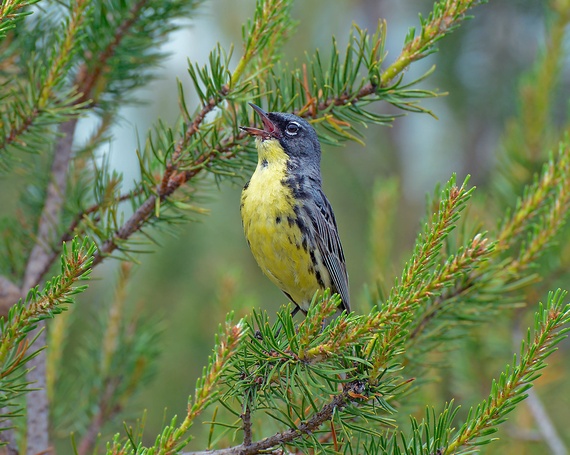The Crowdrise Holiday Challenge will be over in less than 24 hours, and with its closing the first dedicated push to raise dollars for securing a bright future for the Kirtland's warbler comes to an end. In this piece, Kay Charter explains that saving this rare songbird means gaining everyone's understanding of the interconnection of habitat and survival and that sustaining this means committing for the long-haul. Pledge your support today - the Challenge ends Thursday, January 9th at 12pm EST.
By the time the Kirtland's warbler was listed under the Endangered Species Act, the U. S. Fish and Wildlife Service was already hard at work to save the bird. Brood parasitism (when birds drop their eggs in the nests of other birds, often leading to starvation for host nestlings) by brown-headed cowbirds had been identified as the reason for poor nesting success so trapping was underway. And Michigan's jack pine forests were being managed for optimum breeding habitat. Why, then, did population numbers continue to slide, and what change in management practices led to the great successes of the twenty-first century?
In 1987, population numbers sank to a mere 167 males, the second time that low was reached in recorded history. Because recovery efforts had been underway for more than a decade, the continued decline caused some researchers to think the bird was headed for extinction. Not so Jerry Weinrich, a retired Michigan DNR wildlife biologist, who spent 31 years working with the warbler. Not only is Weinrich an optimist, he also takes a very long biological view. He believes that over the history of the planet, some species have experienced population "pinches," when available habitat is reduced. In his view, the Kirtland's warbler is a potential example of such an occurrence.
During the ice age, jack pines were pushed down into northern Florida and Georgia. During that time, the birds' populations may have sunk to low levels, eventually recovering with the retreating ice shield. If Weinrich is correct about occasional tightening of species populations, that explains his optimism about the warbler's ability to recover. But it does not help us understand why Kirtland's numbers were sinking at a time when the recovery team was working to bring the bird back.
The answer lies, as it often does, in habitat. Or, perhaps more accurately, it had to do with the ecosystem required for nesting success. If we think of habitat as an area where an organism occurs, and Kirtland's Warblers nest in jack pine habitat, then why don't we find this iconic bird breeding across much of eastern Canada, where the trees flourish? That's because ecosystems consist of interconnected and interacting parts, each of which is necessary for the whole to function. In the beginning, biologists focused on providing young jack pine forest habitat rather than on the complexities of the ecosystem required by the birds.
While early researchers understood that the birds only nest in young stands of jack pines, they did not know that other vegetation, especially oaks, wild cherries and blueberries, are integral parts of the specific jack pine ecosystem required by Kirtland's Warblers.In early management efforts, deciduous vegetation was removed from the young forests. When the team learned that the first arriving males establish territories where there are oaks, cherries and (sometimes) blueberries, management protocol changed. That is not surprising as oaks and cherries host high numbers of caterpillar larvae. These caterpillars constitute a vital protein and fat source for virtually all warblers, and are essential to nesting success. As for blueberries? Few warblers depend on berries; but the Kirtland's diet includes a considerable numbers of blueberries when they are available.
With this new protocol, the population rebounded. Last year's singing male population was over 2000 individuals. The target number for recovery was a thousand. Does that mean we can pat ourselves on the back, say "Job well done," and leave the bird to continue on its own path without our involvement? Unfortunately, it does not.
This beautiful bird is one of the species that will always require active conservation efforts. Cowbird trapping must continue, and trees will have to be cut or burned to create the young forest the birds require. The first hurdle in saving the Kirtland's warbler has been successfully mounted. Maintaining that success into the future depends on our understanding that this bird is unique and priceless, and in our willingness to meet the challenge to keep it here.
Kay Charter is passionate about birds and bird conservation. She is co-owner of Charter Sanctuary, a member of the Kirtland's Warbler Alliance and Executive Director of Saving Birds Thru Habitat in Omena, Michigan (savingbirds.org). Support the incredible comeback of the Kirtland's warbler by donating through the Crowdrise Holiday Challenge.
Huron Pines is a 501(c)(3) organization and an equal opportunity provider with a mission to conserve the forests, lakes and streams of Northeast Michigan. Learn more about our projects by visiting www.huronpines.org
